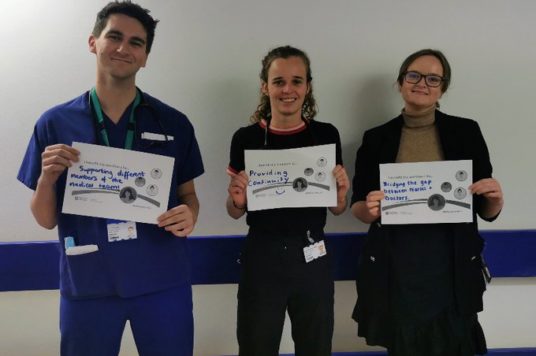Meet our Physician Associates, as awareness week gets under way!
It’s Physician Associate Awareness Week – and to mark the occasion, we’ve spoken to staff about their jobs and what they most enjoy about them.
You may not have heard of a Physician Associate – or PA – before, but they play an important role in our teams.
PAs are medically trained, generalist healthcare professionals, who work alongside doctors and provide medical care as an integral part of a multidisciplinary team.
St George’s, Epsom and St Helier Hospitals Group is one of the biggest employers of PAs in the country, with 70 working across our sites in specialities ranging from emergency medicine to frailty, and dermatology to infectious diseases.
Our hospitals group now has a joint teaching programme covering topics from the PA curriculum, and PAs have also worked across our sites since 2010.
Read more about the job, and what a typical day looks like, from three of our Physician Associates below!
Fabiola Hatahintwali, Acute Medicine Physician Associate, based at Epsom and St Helier
How I became a PA
I had always had a particular interest in healthcare and human science. For my undergraduate degree I chose biomedical science with the view to work in the laboratory or go into research. However, after experiencing the realities of being in the lab for most of the day, I realised I needed more interpersonal interactions and patient contact. In my final two years of my degree I worked in a nursing home, which highlighted this further. In my final year of biomedical science, a qualified PA made a presentation to promote the profession, and this was my first exposure to the role. After further research, I applied and got onto a two-year master’s course.
What my day-to-day looks like
Currently I am working full time in the Same Day Emergency Care (SDEC) clinic. A typical day in SDEC clinic consists of seeing patients that are referred to the service via three pathways; follow-up from the wards, our Emergency Department, and same-day assessment of patients referred via their GP. They can also be referred for procedures such as pleural drains/taps if they don’t need admission to hospital. I will see a wide variety of patients with often multiple complex co-morbidities. On days I run the clinic, I also review patients for IV infusions and liaise with the nursing ED team.
My job in acute medicine has changed slightly since I first began. It can range between three different roles, including ward, clerking (on call) and clinic. When on the ward, as a PA you would do a ward round with the consultants every morning and complete any outstanding jobs that need to be done for the patients for the rest of the day. On a clerking shift, you are part of the on-call medical team and assess any medical patient from ED. I will take a history, order any relevant investigations needed, and begin management until the consultant takes over.
What I like about being a PA
In the clinic environment, I am able to work with regular patients that I can follow up and build good rapport with. The variety of conditions that we assess and follow up also makes the job interesting as wo days are the same. There is a lot of independence in clinic, and although there is always supervision, you are able to formulate your own proposed differential diagnoses and management.
Joseph Henley, Physician Associate in Acute Medicine and Senior Health, based at St George’s
How I became a PA
I studied biological sciences with a year abroad at the University of East Anglia for my undergraduate degree. UEA had just started training PAs the year I graduated, and this led me to research more about the role.
I knew gaining some clinical experience would help set me up for training and so I got in touch with a dermatology practice in the USA, and they very kindly offered me a 30-day shadowing opportunity, following and assisting their PAs. This convinced me that the PA role was a very good fit for me. I researched different UK universities that trained them, and this led me to apply for the Masters of Physician Associate Studies at St George’s University. I successfully completed the programme and passed the national examinations in October of last year.
What my day-to-day looks like
Currently I am based on a geriatric ward. My day starts in the doctors’ office, preparing ward round notes and reviewing investigation results with my colleagues. Following this we then start reviewing patients on the ward round, I often do this with a consultant, or I may be asked to see patients on my own and discuss them at a later time. After the ward round I then generally start completing jobs, such as discussing cases with different specialities, getting scans vetted, performing procedures such as venepuncture (taking blood), or providing next-of-kin updates.
What I like about being a PA
One of my favourite things about the role is the sense of comradery we can bring to different members of the team. The relationships I build with nurses, doctors and allied health professionals helps bring these different members together, and has me looking forward to going to work each day.
I also really enjoy performing clinical procedures such as cannulation, obtaining blood gases and venepuncture. I’m hoping to be trained in more complex procedures soon.
Chandran Louis, Physician Associate in Urology, based at St George’s, and Senior Lecturer at St George’s University of London
How I became a PA
I initially studied human biology and worked in NHS management but I knew that I wanted something patient facing and that is why I enrolled on to the PA programme in 2012. Back then there was one university providing/offering the course in England and there were limited job opportunities so it was a huge leap of faith and it paid off!
What my day to day looks like
I have a varied week as I work for two employers, and also hold a role at the Faculty of Physician Associates.
As an example from last week – I spent Monday and Thursday in different hospitals, and on Tuesday I worked for the St George’s University of London and the Faculty of Physician Associates as Vice President.
On Wednesday I was back at George’s Hospital, where I had a mixture of ward work and meetings. The day kicked off with our X-ray meeting and our teaching session straight after. The rest of the day was spent on the ward completing jobs.
On Friday I returned to St George’s University of London to participate in clinical exam skills. This is where the students apply their knowledge and practice their skills in examining patients.
What I like about being a PA
In my clinical role I do enjoy engaging with patients and also providing a holistic assessment of the patient.
As we draw near to the end of 2022, I reflect back on how the profession has grown over the last 10 years both locally and nationally.
When I first started at St George’s we had around 20 PAs, to go to 54 PAs is massive achievement. St George’s, Epsom, and St Helier Hospitals Group has been leading the way on where PAs work, and I am very proud to be a part of that.
Notes to editors
To find out more about a career as a Physician Associate, visit: https://www.healthcareers.nhs.uk/explore-roles/medical-associate-professions/roles-medical-associate-professions/physician-associate/physician-associate


